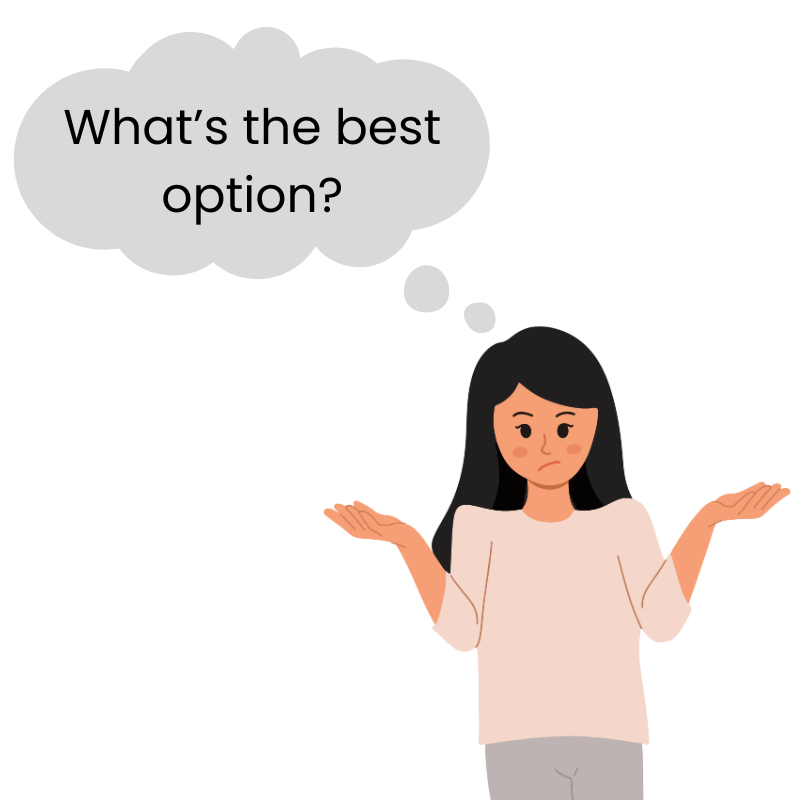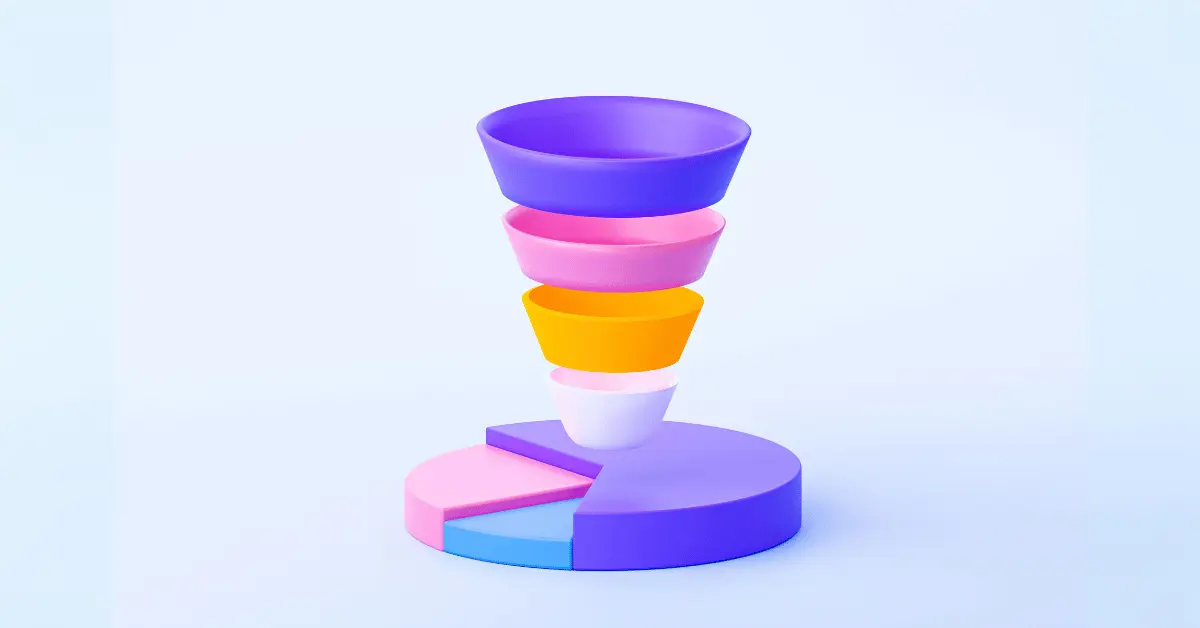Table of Contents
Understanding the Conversion Funnel

The conversion funnel represents the typical buyer’s journey, starting from the time they first recognize a need or desire and ending with their final decision on whether or not to purchase.
The traditional conversion funnel follows this path:
- Top of the Funnel (TOFU): At the initial stage, content is designed to generate awareness, primarily by introducing a potential problem or need that people may not yet realize exists.
- Middle of the Funnel (MOFU): In this stage, the focus shifts to helping customers learn more about the problem or need while narrowing down their options to find the best solution.
- Bottom of the Funnel (BOFU): In the final stage, content is typically focused on earning the conversion. It targets people who are ready to buy, but need to be convinced that the proposed solution or product is the right choice.
However, not all buyers will follow the traditional conversion path. The level of investment involved plays a significant role in the journey:
- Higher Stakes: For purchases that are costly or where a poor decision could have significant consequences, buyers are more likely to spend time in the TOFU and MOFU stages. This allows them to gather all necessary information to decide whether a solution is needed and, if so, what options are available.
- Lower Stakes: For low-cost or low-risk purchases, people tend to spend less time in the TOFU and MOFU stages. While at least some engagement with content in the MOFU stage is likely, there’s a good chance they’ll proceed directly to the BOFU stage to quickly try out the product or service.
This does not mean that you should ignore TOFU and MOFU content, even for products and services that are low-stakes. Having content in these areas is still important for building topical authority, gaining user trust, and making sure your brand is visible in all the possible touch-points that your audience will come across. You are much more likely to convert someone who has seen your brand before compared to someone who landed on your conversion-focused BOFU pages without any previous exposure.
Even if potential customers first encounter your brand through conversion-focused pages, many of them will still explore your website to gauge your trustworthiness and assess your expertise in what you’re recommending or selling before they commit to a purchase.
TOFU: Top of Funnel (Awareness Stage)

At the very top of the funnel is the TOFU/awareness stage. Here, content aims to make potential customers aware of an unrealized problem or need. While they might already have some awareness, the issue often isn’t pressing enough to spur them into action without additional exposure to remind them of it.
A good example of this is the articles featured in Google Discover. Without having to remember anything or conduct a search, people can browse a news feed of what is typically TOFU-style content, effectively entering them into the top of the conversion funnel. But you aren’t just limited to news feeds with TOFU content – search queries returning this type of content often have high search volume (albeit low conversion rates) because people are often reminded of these topics through other channels like radio ads, conversations with friends and colleagues, social media, and TV.
To illustrate this, let’s imagine you own a coffee company that sells ethically sourced, fair-trade coffee beans. You might hypothesize that there are people who would consider purchasing fair-trade and ethically sourced coffee, but are not currently doing so as it’s not something that’s at the top of their minds.
So, to target both groups of people (those who might stumble across the article in a news or social feed, and those who may actively search for the topic of fair-trade), you create a blog article titled “The True Cost of Your Coffee: A Look Into Fair Trade Practices”.
This title is catchy, piques interest, and suggests there’s something nefarious about the coffee industry. What coffee lover wouldn’t be at least a little interested?
Your goal with this sort of article isn’t to immediately persuade readers to buy ethically sourced coffee or to pitch your product as the solution. Suggesting your product too soon could raise doubts about the genuineness and motive of the article. Plus, given that readers are just becoming aware of the issue, the chances of them instantly altering their coffee buying habits are slim.
Instead, your goal is to make readers aware that not all coffee is ethically sourced, highlight its impact on small coffee farmers, and offer insights into coffee trade practices. This puts the issue at the top of their minds, at least temporarily, and some readers may move further down the conversion funnel to learn more about fair-trade practices and whether it’s a big enough issue for them to change their buying habits.
If your website has a clear purpose, user-friendly design and navigation, strong branding, and follows good content practices like internally linking to relevant pages, the ideal scenario is that some readers explore more about fair-trade coffee directly on your site.
The next best scenario is that another group of readers search for more information online, ideally finding your MOFU and BOFU content and coming back to your site, but this time they are more inclined to change their coffee-buying habits.
And of course, you’ll still have a group of readers who read the article and decide to look no further into it, which is out of your control and not something you should worry about. Your focus should be on providing answers for those who are ready to progress further down the funnel.
Examples of TOFU Searches
- “Fair-trade coffee meaning”
- “Is the coffee industry ethical”
- “Dark side of the coffee trade”
MOFU: Middle of Funnel (Consideration Stage)

In the middle of the conversion funnel is the MOFU/consideration stage. Here, content aims to nurture users from the TOFU stage who have chosen to do further research on whether a decision needs to be made. These individuals are already somewhat engaged and are ready to explore the topic more thoroughly and consider their options.
Let’s continue with our coffee company example. Whether it’s the interest sparked by your informational blog post on fair-trade coffee or curiosity stemming from other sources, it’s clear that some people are now ready to learn more about fair-trade practices.
So, you create another blog article titled “How to Tell if Your Coffee is Fair-Trade”.
Your goal with this article is to provide more in-depth information while subtly positioning yourself as a possible solution. Many readers at this stage are still evaluating the pros and cons of taking action, so your content should provide all the necessary information to encourage them to switch to ethically-sourced coffee.
Your content should blend informative content with subtle selling points and conclude with a strong call-to-action (CTA). The selling points can emphasize how your coffee adheres to fair-trade standards, positioning your brand as a potential choice, while the CTA targets those who are ready to try ethically sourced coffee immediately.
If you do a good job of weaving the commercial aspects into your content, this article could very likely be the initial stage where you earn customers.
This is also where your website has a chance to shine. Even though some readers might start searching for BOFU-style queries, a well-structured website with clear navigation and compelling product pages can guide them towards making a purchase directly on your site.
Understand that not everyone will be ready to purchase yet, as many people like to explore available options before committing to a purchase. However, by creating content for this stage of the funnel, you have successfully generated interest and consideration for your product.
Examples of MOFU Searches
- “Benefits of fair-trade coffee”
- “Difference between fair-trade and regular coffee”
- “Is Folgers fair-trade”
BOFU: Bottom of Funnel (Decision Stage)

At the bottom of the funnel is the BOFU/decision stage. Here, content is primarily focused on conversions, featuring in-depth product information and sales-oriented copy to persuade people that your product or solution is the best choice.
Continuing with our coffee company example, you might have a few options at this stage:
- Strong Category Pages: Display your range of fair-trade coffee, effectively targeting those looking to purchase such products and visitors from your MOFU content exploring your site.
- Detailed Product Pages: These might include elements like high-quality images, comprehensive product descriptions, trust indicators like badges or certifications, and detailed information about sourcing, roasting, and flavor profiles.
- A BOFU Blog Article: An example could be “Savor with a Purpose: The Superiority of Our Coffee’s Fair-Trade Approach,” capturing additional search traffic for varied queries where your category and product pages might not appear.
Whether users land on your category pages, product pages, or read your blog article, your objective at this stage is to convince them to choose your products over competitors.
This requires creating trustworthy pages that provide all necessary information for users to decide if your company is the right fit for them. As BOFU pages often drive the highest revenue, they are often A/B tested to identify which combination of site elements, copy, and formatting lead to the highest conversion rates.
Examples of BOFU Searches
- “Best fair-trade coffee”
- “Fair-trade coffee beans”
- “{Brand name} coffee”
Tying It All Together
The conversion funnel for your coffee company now looks something like this:
- Awareness Stage: An article introducing the concept that coffee growers often face exploitation and highlighting the significance of fair-trade coffee.
- Consideration Stage: An article that educates readers on how to tell if coffee is fair-trade, elaborates on its importance, and introduces your product as a possible option.
- Decision Stage: Content, be it an article, category pages, or product pages, that goes into the specifics of your coffee beans, demonstrating why your brand stands out as the ideal choice.
Strategies for Optimizing Each Funnel Stage
Each stage of the conversion funnel should use slightly different strategies to maximize their potential. You should be thinking about how readers will engage with your content and what their primary goal is for engaging with it.
Awareness Stage
High-level blog posts, infographics, and videos are easy to consume and do an excellent job of introducing a topic. Remember, you’re trying to convince people who aren’t necessarily thinking about or invested in your content yet. Keep your content entertaining and add visual elements that help convey your message. You can promote this type of content on social media to help spread awareness and encourage people to share, netting you more potential customers.
Consideration Stage
Product or brand comparisons, how-to guides, and case studies are great formats for the consideration stage of the funnel. Your content should blend informative copy with commercial aspects to capture possible conversions from people who are ready to purchase. If you have an email list, you can use targeted campaigns to nurture leads who have shown interest in your TOFU content. You can also run retargeting campaigns to keep your brand visible to people who have shown interest.
Decision Stage
Product overviews, customer reviews and success stories, and optimized landing pages work well for the decision stage of the funnel. At this point, users likely have already decided that they need a solution – it’s your job to convince them that you’re the ideal choice. Conversion-rate optimization (CRO) should also be a focus, as you want to test different formats, site elements and CTAs to see which version of your page has the highest conversion rate.
Final Thoughts
The buyer’s journey throughout the conversion funnel isn’t always straightforward, but you can (and should) create content at each stage of the funnel to maximize your chances of earning conversions. Creating content in all three stages helps generate awareness, capture search traffic, attract users into the conversion funnel, build topical authority, enhance trust, and ultimately lead to conversions.
Your strategies for each stage of the funnel should be tailored to what the reader is wanting to do and how much exposure they’ve already had to the topic. Use your available channels to promote your content for a wide reach, retarget users who have shown interest, and create and test optimized landing pages to make choosing your product or service an easy choice.



0 Comments